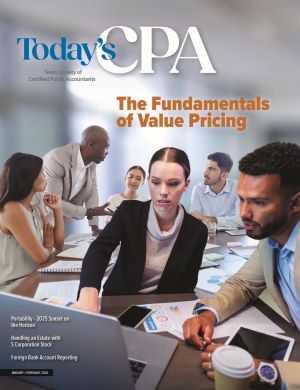January 24, 2024
The Fundamentals of Value Pricing
By Ed Kless
Pricing for profit is critical to the health and success of your business, yet many firm owners just don’t realize the impact that pricing has. When you set your prices correctly, you gain a significant edge over your competitors.
By contrast, when you set your prices incorrectly, it can be very hard to recover. So, how do you set your prices correctly?
Setting Prices Correctly is Key to Your Firm’s Success
Many firm leaders don’t realize that pricing is the top driver of profitability for almost every kind of business, including accounting firms. Study after study by many different consultancies has confirmed this fact.
For example, research by McKinsey and A. T. Kearney revealed the following:
• 1% increase in price can yield an increase in profits of 7% to 11%;
• By contrast, a 1% reduction in fixed costs improves profitability by only 1.5% to 2.7%;
• And likewise, a 1% improvement in revenue raises profitability by only 2.5% to 3.7%.
Biggest Mistakes to Avoid in Setting Prices
The single biggest mistake businesses make is setting prices too low and then having to raise their prices after they’ve been in business a while.
A second significant mistake is offering one and only one price. Firms that are effective at pricing, without exception, give their customers choices in their prices. Take the Starbucks model, for example: you have multiple size options – tall, grande and venti. FedEx and UPS also offer a variety of options – standard overnight, priority overnight, two-day delivery and so on.
Firms should give their clients price options because there is a range of acceptable prices a client is willing to pay based on the value they perceive in what they’re purchasing. On the other hand, if your business offers only one choice, it’s difficult for your client to establish a context around the price. Multiple price options based on what’s being sold help the client establish that context and choose the product or level of service they desire.
Sadly, many firms attempt to correct for this by quoting a low-to-high range. This creates friction in the relationship from the beginning since the prospect/client will only remember the low and the professional will only remember the high. In addition, it is confusing. Imagine going into a store and seeing the price of milk as between $3-$6.
Example Professional Firm Offering
Let’s begin by creating a grid with the three options down the left and the first feature of the access level (response time) across the top. We will use the American Express “Green, Gold, Platinum” metaphor and response times of six, three and one hour(s), respectively. Please note, your mileage may vary (as they say in the car commercials). It could be that your clients expect quicker response times and that your offering would be for one-hour, 30-minute and 15-minute responses. This is just an example to assist your thinking. Please see Table 1.
| Table 1. Access Levels and Response Times | |
|---|---|
| Access Level | Response Time (In Business Hours) |
| Platinum | 1 |
| Gold | 3 |
| Green | 6 |
Notice the first level presented will be the most expensive. We’ll discuss more on why this is later.
To clarify, what you are offering is your guarantee that you will respond to a client with the selected level’s response time. You are not saying you will be able to answer their question or solve their problem within this time, just that you will be able to respond to them and begin the process of diagnosing the situation for them.
Now, it may be that you can answer the question or solve the problem, but it is important that you explain that this will not always be the case. Many organizations that have implemented access-level agreements refer to these as diagnostics and just like with a doctor, a diagnosis is not the same as a cure.
The next step is to create more offerings to go across the top. Some of the more common offerings include frequency of face-to-face meetings, tax and estate planning, and agreeing to meet with other professionals such as financial planners or lawyers to discuss a matter relevant to the client, representation before the IRS and so on.
Now let’s add some of these across the top and drop in some ideas about what is or is not included at each level. Please see Table 2.
| Table 2. Access Levels, Response Times and Offerings | ||||
| Access Level | Response Time | Face-to Face Meetings | IRS Representation | Main Professional Coordinator |
| Platinum | 1 Hour | 3 | Power of Attorney and Response | Yes |
| Gold | 3 Hours | 2 | Power of Attorney, Call to You | Yes |
| Green | 6 Hours | 1 | Advice Only | No |
| No Plan | 2 Days | 0 | None | No |
As a reminder, this is an example; your access-level agreement will likely contain a dozen or more features across the top. The number of items you can bundle in is limited only to your creativity. A great place to start is to talk to your clients about their needs and wants. Take a group of clients to breakfast or lunch to brainstorm ideas. Be sure to include different types of clients both from a demographic and psychographic standpoint. Include some of your best clients, as well as some of your clients who don’t think you are so great.
Including the clients who do not think you are so great has a two-fold purpose. First, when they talk to some of your better clients, they may get a better understanding of what you are able to do for them, as well. I have witnessed a D customer become a B customer by just talking to an A customer.
Second, it allows you to observe what not to build into your agreement. You do not want to create an agreement that will attract more D-type clients.
Key Difference Between Cost-Based Pricing and Value-Based Pricing
This topic is often misunderstood. Sadly, most people think price should be based primarily on cost. In fact, often business owners think only about cost when it comes to setting price. In the vast majority of cases, however, cost should not be the number-one driver of price!
What should be the primary driver? It should be the perceived value the client places on the service or product. That’s not to say that value is the sole determinant of cost – pressures from your competitors, as well as other factors also get considered when setting price. However, in my experience, most people think cost is the top driver in setting price, when in fact value is the top driver.
This concept is known as value-based or value-led pricing. Central to this concept is the idea that the value to the client of your service or product enables you to set a price and then the price you can get justifies your costs.
How to Set Prices Based on Value-Led Pricing Model
The first concept that firms adopting value-led pricing need to absorb and act on is that there is no such thing as the objective value of a product, service or knowledge being sold. Value is entirely subjective to the client and, to some extent, the circumstances and situation at hand.
That means that in order to properly set the price, firms need to understand what’s the subjective value to the client. Let’s take a simple example. A bottle of water an individual buys at a sports stadium (especially on a really hot day) is worth a lot more to that consumer than when they pour themselves a glass of water from their kitchen faucet.
Likewise, the same water when flooding your basement has negative value. From a cost standpoint, getting the water to those locations is the same. Again, prices are not based on costs; they justify them.
A second key change in mindset is to understand that your firm should price your clients – not your services or products. For example, professional services firms like accounting firms might price individual clients based on the value to the client of the firm’s services. A multinational cell phone carrier, meanwhile, will price a large segment of clients they want to target.
How Much Time Should You Devote to Tracking Your Competitors’ Pricing?
Naturally, you need to be aware of what your competitors are charging for their services and products, and you want to understand the contexts they’re establishing that help their clients determine value. But very few small businesses should devote much time and resources to monitoring competitors’ prices.

It’s more important to figure out how to differentiate what you do compared to your competitors and to make what you sell truly different.
About the Author: Ed Kless joined Sage in 2003 and is currently the senior director for partner development and strategy. He hosts the Sage Thought Leadership Podcast, found at http://sagethoughtledership.com/ and a weekly radio show, The Soul of Enterprise, for the VoiceAmerica Business Channel, found at http://thesoulofenterprise.com. Contact him at Ed.Kless@sage.com.

















